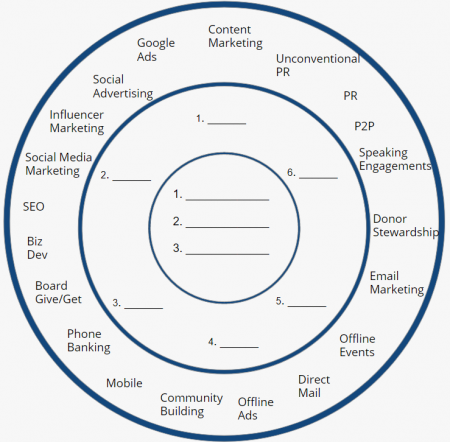Nonprofit Marketing and Fundraising Traction Channels Guide
7 min to read ✭
What nonprofit leaders will learn from this post:
The below post, “Nonprofit Marketing and Fundraising Traction Channels Guide” has been designed to empower nonprofit marketing and fundraising leaders (that are often dealing with tight budgets and limited resources) to:
- Understand, rank and prioritize the different nonprofit marketing and fundraising traction channels
- Apply the bullseye framework to successfully strategize, execute, evaluate and scale an organization’s revenue and impact as effectively as possible
We recommend both watching the video, reviewing the entire post and then downloading and working through the traction channel ranking table and bullseye framework with your marketing and fundraising team.
Key section links of this post:
- Overview of the NPO Marketing and Fundraising Traction Channels Guide
- Description and Examples of All Nonprofit Marketing and Fundraising Traction Channels
- NPO Traction Channels Ranking Table and Bullseye Framework
It’s time to gain some serious marketing and fundraising traction! Happy learning.
Overview of the Nonprofit Marketing and Fundraising Traction Channels Guide
Overview
How does your nonprofit organization define marketing? Contrary to popular belief, marketing is about acquiring attention, not just impressions.
When nonprofits’ fundraising campaigns come up short and fail to hit internal goals and objectives, it’s common for marketers to place blame with campaign themes or lack of creative messaging. In reality, many fundraising campaigns fail from not having enough donors.
Nonprofit marketers and fundraisers need to spend at least 50% of time on campaign creative and 50% of time on campaign traction. If a nonprofit spends less than 50% of time on campaign traction, the organization risks not spending enough time on donor acquisition efforts.
Regardless of an organization’s annual budget is, the vast majority of nonprofits have small, resourceful marketing teams. Often nonprofit’s marketing teams have limited bandwidth, various roles and operate with a lean team.
At Community Boost, we apply startup methodologies when supporting the social sector on the marketing and development front. Based on “Traction: How Any Startup Can Achieve Explosive Customer Growth” by Gabriel Weinberg and Justin Mares, we have adopted the bullseye framework for the nonprofit social space specifically.
When a nonprofit marketing team has limited resources, it is imperative to prioritize the team’s efforts on the most scalable marketing channels. The nonprofit traction channel worksheet is designed to help your team rate and prioritize your marketing efforts.
How It Works
The primary goal for your nonprofit’s marketing team is to invest the majority of your time and resources into the marketing channels that are moving the needle on online revenue.
Step 1.) Understand the different nonprofit traction channels
Step 2.) Complete the Nonprofit Traction Channel Ranking Table and Bullseye Framework
Step 3.) Strategize, execute, evaluate and scale your top three traction channels. It is imperative to focus and invest heavily in your highest potential channels.
Description of Key Nonprofit Marketing and Fundraising Traction Channels
Overview
Below is a quick description and example of the twenty different nonprofit marketing channels your nonprofit can test and implement to drive campaign traction.
Search Engine Optimization (SEO)
Description: Good SEO means free traffic from keywords that you organically rank at the top of Google for, which in turn can mean a customer or donor acquisition cost of zero or near zero. Search engine optimization (especially for non-branded keywords) is a long-term game, especially for new organizations with low website domain authority.
Example: Charity Water ranks number one on Google for the keyword, “donate to clean water”, generating hundreds of relevant site visitors a month.
Social Media Marketing
Description: Targeting social networks and applications such as Facebook, Instagram, Twitter, Pinterest and more, to generate brand awareness and engage with constituents.
Example: To Write Love On Her Arms has built a Facebook following of over one million fans that engage and share TWLOHA’s content on the social platform.
Social Media Marketing
Description: Targeting social networks and applications such as Facebook, Instagram, Twitter, Pinterest and more, to generate brand awareness and engage with constituents.
Example: To Write Love On Her Arms has built a Facebook following of over one million fans that engage and share TWLOHA’s content on the social platform.
Influencer Marketing
Description: Connecting and encouraging key leaders with large followings to promote your organization and campaigns.
Example: Kiss The Ground has enrolled singer songwriter Jason Mraz in the past to not only promote and make a stand for the organization, but also serve as a strong brand advocate.
Social Advertising (Facebook and Instagram Ads)
Description: Leveraging social ad platforms like Facebook and Twitter, can be a scalable way to reach new donors as well as, remarket to past donors or customers.
Example: Upload an email list of past donors to Facebook to run hyper-targeted Facebook campaigns to both past donors and look-alike audiences.
Search Engine Marketing (Google Ad Grants)
Description: Search engine marketing (SEM) allows organizations to advertise to potential supporters who are searching on Google and other search engines. The majority of charitable nonprofit organizations can apply and receive a $10,000 per month Google advertising grant.
The Google Ad Grant does have some stipulations (such as the $2.00 max cost per click limit) however, Google Ad Grants is still the best way for nonprofits to begin running search ads, rank on the top of Google for non-branded keywords and send upwards of an additional 5,000 or more monthly site visitors.
Example: Wounded Warrior Homes, a small nonprofit based in San Diego, California, leveraged their Google Ad Grant to generate 78 direct donations from users who searched keyword in Google such as “veterans who are homeless,” “donate to veterans” and “donate to military families.”
Content Marketing
Description: Most nonprofits have blogs. However, most nonprofits don’t effectively leverage their blog to gain fundraising traction.
Example: To Write Love On Her Arm’s blog showcases? how the organization lives into its mission to present hope and find help for people struggling with depression, addiction, self-injury and suicide, but also is a valuable channel to guide supporters back to the website.
Email Marketing
Description: Email marketing is the practice of sending informational, promotional or transactional emails to segmented lists in order to re-engage and increase lifetime value.
Example: Pencils of Promise leverages effective email marketing sequences to onboard, inspire and support new fundraisers. Email marketing is the practice of sending informational, promotional or transactional emails to segmented lists in order to re-engage and increase lifetime value.
Business Development (Partnerships)
Description: Business Development (BD) is the process of creating strategic relationships that benefit both your nonprofit and partners. It is similar to sales, but instead of going one to one, you are partnering to go one to many in a way that benefits both parties.
Example: Some organizations’ partner with grocery stores to fundraise on their behalf
Peer to Peer Fundraising
Description: Peer-to-peer fundraising leverages supporters to crowdsource and tap their networks on behalf of your organization. If an organization is looking to effectively execute peer-to-peer fundraising, at Community Boost we recommend the Classy platform.
Example: Barbells for Boobs has inspired its niche and passionate audience to leverage peer to peer fundraising to drive both awareness and revenue so that the organization can mobile and empower people to take action in breast cancer.
Speaking Engagements
Description: Speaking engagements are a worthwhile tactic to increase volunteers and donors. However, organizations must be selective in determining which opportunities to pursue and ensure their message is being shared with the right audience that is interested in the mission and willing to support.
Example: Urban Street Angels gained volunteer and donor traction by speaking at local Rotary Club meetings.
Public Relations
Description: Public relations (PR) is a communications practice that allows organizations to build relationships with the media to further highlight their brand visibility. PR professionals craft and share stories to local, business and trade press about organizational offerings and distinct advantages in the market. t the practice of reaching out to magazines, newspapers, blogs and other media outlets to have them feature a story about your organization. If an organization has unique offerings, compelling results or thought-provoking commentary from the executive team, their chances of inclusion in a piece is likely.
Example: , When it comes to public relations, nonprofits should implement a e “ladder up” strategy where the focus is on gaining recognition in blogs and niche publications pertaining to your specific audience.
Unconventional PR
Description: Unconventional PR is when organizations execute campaigns or activities that gain tremendous media exposure, such as a publicity stunt.
Example: Movember is an organization that has utilized unconventional PR tactics by encouraging its supporters to grow mustaches to show support for men’s health. This campaign resulted in tremendous traction in communities when coupled with peer-to-peer fundraising.
Offline Events
Description: Offline events, trade shows and networking opportunities are an effective way to engage people, albeit less scalable. Creating events or hosting groups via Meetup.com gives your community the chance to connect and share the mission at hand.
Example: If your nonprofit is committed to ocean conservation and you start a monthly beach cleanup meetup group, you will undoubtedly attract like-minded individuals to your cause.
Direct Mail
Description: Despite the world transforming into a digital marketplace, direct mail is certainly not dead and performs very well still for many nonprofit organizations. Be careful to not send too much direct mail, however, year-end appeals are almost mandatory, especially when targeting Baby Boomers and the Silent Generation.
Example: The St. Baldrick’s Foundation has a superior digital presence yet leverages direct mail to support its integrated marketing and fundraising mix.
Offline Ads
Description: Offline advertising like radio, billboards or print ads are at times infeasible for many price-sensitive nonprofits. Regardless, it is possible to find “remnant advertising” or XX, and take advantage of Public Service Announcements or PSAs.
Example: A nonprofit is able to run a 30-second radio PSA ad
Community Building
Description: Many for-profit companies use community building to drive impact and sales, like Yelp and Wikipedia. Nonprofits can also build communities, either online or offline, to engage supporters.
Example: The Trisomy 18 Foundation is a nonprofit that first gained traction by building an online community to provide support for families that were dealing with a Trisomy 18 diagnosis during pregnancy. The T18 Foundation’s online community is still a cornerstone of the organization’s mission and impact.
Phone Banking
Description: Making outbound calls to potential and past donors and customers can still drive strong revenue for your organization.
Example: During an organization’s year-end campaign, having board members call previous donors and share the past year’s impact, can be critical for success..
Board Give/Get
Description: According to a 2007 BoardSource survey, it was estimated that 27 percent of nonprofit boards have a minimum giving requirement and 28% require board members to donate, but do not specify any amount. While some argue that a Board Give/Get Policy takes away from good governance, implementing a board to fundraise is a common practice for many nonprofits.
Example: Board members for an organization are required to either give themselves or get (fundraise) a certain amount.
Donor Stewardship
Description: Donor stewardship is the practice of ensuring high quality interactions to foster long-term engagement and investment in the mission from donors.
Example: Project Concern International launched the Touch Initiative in 2016 to tell, transport and thank donors in a special way, primarily focused on individuals that gave less than $10,000. The goal of the initiative was to cultivate small annual donors into mid-level donors. PCI would record YouTube videos from staff and email them to donors.
Mobile Messaging
Description: Mobile messaging is the practice of sending messages to mobile devices, typically as text messages via SMS.
Example: Nonprofits that provide a way for their audience to select their communication preferences will likely see increased engagement if they send text messages in the evenings to supporters that have requested that communication loop.
Nonprofit Traction Channels Bullseye Framework

Rank and place your nonprofit’s top three nonprofit traction channels in the center ring.
These are the key channels your nonprofit marketing team should invest the majority of its time and resources into to drive new supporters, donors and customers.
For each key channel, be sure to identify Key Performance Indicators (KPIs) that you will be measuring. For example, if you set a target Cost to Acquire a donor metric for Facebook ads for example. Now your team can continue to invest time and resources to effectively scale this key channel.
Conclusion:
We hope that you have the Nonprofit Marketing and Fundraising Traction Channels Guide helpful. It is our intention that this strategic framework will empower your nonprofit leadership team to strategize, execute, evaluate and scale the highest revenue-generating channels for your organization faster and more effectively.





13 Comments
Nancy Jagaselvan, on April 15, 2018 at 1:34 am
This is great content and useful for non-profit organizations.
lupe, on July 5, 2018 at 6:19 pm
thank you for the tips. how do I download the PDF though?
lupe, on July 5, 2018 at 6:19 pm
thank you for the tips. how do I download the PDF though?
Pingback:
10 Digital Tactics to Drive Ticket Sales You Need To Know
10 Digital Tactics to Drive Ticket Sales You Need To Know, on April 16, 2019 at 3:05 am
[…] Read more about how Email Marketing can effectively be used to onboard and inspire new supporters in our blog, Nonprofit Marketing and Fundraising Traction Channels Guide […]
Pingback:
Friday Five 010: Maximize Your Digital Marketing Efforts
Friday Five 010: Maximize Your Digital Marketing Efforts, on May 17, 2019 at 6:53 pm
[…] digital marketing channels a nonprofit can take advantage of and really gain traction from. Our Nonprofit Marketing and Fundraising Traction Channels Guide is really helpful for nonprofits who are really looking to grow their digital footprint. There are […]
Pingback:
How Email Can Drive Donations for Your Nonprofit | Campaign Monitor
How Email Can Drive Donations for Your Nonprofit | Campaign Monitor, on September 13, 2019 at 11:55 pm
[…] Source: Community Boost […]
Pingback:
How Email Can Drive Donations for Your Nonprofit | Email Marketing News
How Email Can Drive Donations for Your Nonprofit | Email Marketing News, on September 14, 2019 at 4:09 am
[…] […]
Nonprofit Public Relations, on November 3, 2021 at 6:59 am
This post empowers nonprofit marketing and fundraising leaders, who are often dealing with budget and resource restraints. Thoughtfully organized and through it will teach to gain some real marketing traction. Thanks for sharing!
Nonprofit Public Relations NYC, on January 4, 2022 at 10:22 am
This traction channels guide has a lot of helpful information. Thanks for sharing.